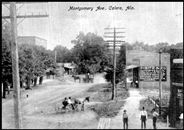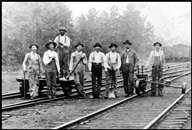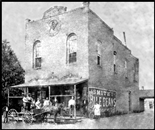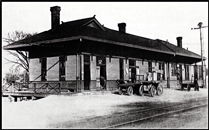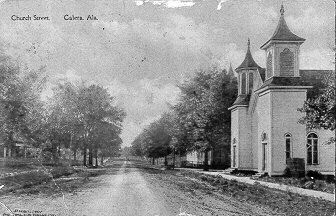|
As indicated in "Early History of Calera, Alabama,"
by Barbara Baker Roberts, published in 1976 by Times Printing Company,
Montevallo, Alabama, the first white settler in the vicinity of Calera, Shelby
County Alabama, was John R. Gamble, 1792-1863. He was a native of Ireland and a
soldier in the American Revolution. Public records indicate that on August 31,
1821 John R. Gamble bought over 100 acres of land, today located approximately
one mile north of Calera. In 1825 he sold a parcel of land located in the Spring
Creek area to William Wilson. However, John R. Gamble and his family were first
indicated in the 1830 Shelby County Alabama census records. Apparently he
decided to leave his Shelby County homestead, and on September 8, 1838 he
applied for membership in the quarterly conference of the Methodist Church at
Gold Mine Camp Ground near the Marion and Walker County line. He was assigned as
a local Methodist preacher on the Blount Circuit of the Walker Mission and spent
the rest of his life in Walker County Alabama.
In addition to John R. Gamble there were a few hardy
pioneers, mainly from South Carolina, who made their stakes at or near Calera
with "farming" as the major occupation. Names of other early landowners before
1850 were (1) William Watson, born about 1816 (2) Richard Green, probable
son-in-law to Elijah Seale (3) Robert Hartley (4) Daniel Muse (5) Virgil N.
Gardner (6) Samuel A. Wallace (7) Maraday Busby, a Methodist Minister, born
about 1788 (8) William Moore (9) Elizabeth Fields (10) Thomas Crim, born about
1814 (11) Hardy Crim, born about 1795 (12) Robert H. Crim (13) Edmund King (14)
John Brooks (15) Rev. William Seale. Only a few
families lived in Calera in early 1850, and the small community was called
Buxahatchie. When the railroad arrived and lime workers came to settle, the
place acquired the name of Limeville. A Confederate post office was
established during the war years, the postmasters during this time were James A.
Mullins, N. McQueen, and H.V. Boyd, and according to early records Daniel T.
Seale served as a mail carrier. Again, some time during the war the name
was changed to Lime Kilns, also referred to as Lime City and
Lime Station. In 1860 "Limeville Baptist Church" was constituted with
fifteen members. The pastor was Daniel T. Seale, son of one of the early
settlers, Rev. William Seale. According to railroad
schedules and post office records, the community name was changed to Calera
between February 21, 1869 and May 10, 1869, when the U.S. post office was
established and the first postmaster was Almon B. Turner, Jr., followed on
December 9, 1870 by Oscar Nabors. Calera comes from the Latin word "calx"
meaning lime.
A major event in the history of Calera was the arrival
of the first railroad, chartered March 4, 1848, and the tracks were laid in
Calera sometime between January 1854 and June 15, 1855. "The first through
trains between Louisville, Kentucky and Montgomery, Alabama through Calera ran
September 28, 1872." Today you can travel back to the railroad age at the
Heart of Dixie Railroad Museum in Calera. The museum contains a
restored depot and railroad cars that sit outside the depot. A train, complete
with snack and gift shop car, passenger cars from 1910-1950, engine, and caboose
takes passengers down the rails through the forest.
While the lime industry gave the community its name and
played a dominant role in Calera's history, it was not until after the
Confederate war did lime become an important commodity contributing to the rapid
growth of the community. "In 1865 this was the only site in the county
burning and shipping lime."
Shelby Guide, dated Thursday, November 30, 1871,
indicate "Calera. - This place is located at the crossing of the S., R. & D.
R.R., and the South and North Railroad. Parties who may desire to establish
themselves in business there, would do well to address R.C. Blichfeldt. The
citizens desire a first class Drug Store, one first class Dry Goods Store, one
first class Family Grocery, Hardware and Crockery, a family who will keep a
private boarding house for 10 or 12 regular boarders, a Baker, a Watch Maker, a
Blacksmith, a Wagon Maker, a Tinsmith, a Shoe Maker and a Barber. As mechanics,
Scandivanians and Germans preferred. As an encouragement to those who may desire
to settle there Mr. Blichfeldt agrees to give a lot in fee simple, to any one
upon which to build a business house, provided the offer is accepted in six
months. Lumber can be laid down at Calera at $12.50 per thousand."
The major industry in Calera continued to be the
manufacture of lime. In 1882 several lime kilns were operating, owned by J.D.
Hardy, N.B. Dare, R.E. O'Brien, and John W. Hardy. In 1883 they formed a
corporation known as the Alabama Lime Company and as indicated in the Shelby
Sentinel, dated January 1, 1885, "Calera had grown to a small town of
about 207 inhabitants."
Another successful industry was the Calera Shoe Factory,
owned and operated by J.H. Dunstan. At the state fair in 1887 the Calera Shoe
Factory won a prize for the best exhibit of Alabama manufactured shoes.
Calera was noted for its fine hotels, boarding houses
and restaurants. The first hotel was built by Mr. Welch in the autumn of 1872.
However, it burned in 1874. The three major hotels, all conveniently located
near the train depot, were (1) The Moss House, owned by Mr. Henry C. Moss,
1847-1904, and operated by Elbert F. Horton. (2) The Calera House, or, as it was
later called, The Calera Hotel or The Campbell House, probably the oldest of the
three, was the major hotel in 1882. It was operated by Mrs. J.D. Campbell. As
indicated in the Shelby Sentinel, dated May 11, 1882, "the building was
rolled closer to the crossing." (3) The Vanderbilt was Calera's most renowned
hotel. It was built in 1882 by Isaac N. Breazeale, 1831-1913, a noted hotel
operator in Calera. A colorful account of Calera's Vanderbilt Hotel is given in
Historic Alabama Hotels & Resorts, by James F. Sulzby, Jr., 1960, pages
255-258. Another noted hotel, The Commercial Hotel, was owned in 1885 by R.M.
Pilgreen, 1839-1934. This hotel, opened under the name, The Commercial Hotel,
was possibly the same as The Calera Hotel.
The Shelby Sentinel, dated January 18, 1883,
indicated that there had been a school in Calera for "two or three years."
The Shelby Sentinel, dated December 11, 1884, indicated the following
people on honor roll for teacher Mrs. E.C. Lawrence, "Jessie Breazeale, Minna
Brame, Mary Mosteller, Carrie West, and Mamie Harrison." On August 7, 1885
the citizens of Calera met to organize support for a permanent public high
school. The first elected officials to serve on the school board were Henry C.
Moss, 1847-1904, Jasper Holcomb, Thomas J. Wells, 1845-1921, Col. John P. West
and Charlton C. Oliver, 1847-1911. Professor Jim Langston served as the first
appointed principal.
"Calera is the best market in this part of the state
for all kinds of produce," as indicated in the Shelby Sentinel, dated
November 8, 1883.
A very popular social activity in Calera was fancy dress
balls. The Shelby News, dated April 2, 1891, indicate that one was given
at The Commercial Hotel in March 1891. Featuring a live band, this occasion was
called the "most entertaining and brilliant event in the history of Calera."
The Calera Journal, dated December 25, 1891, indicated that Mr. and Mrs.
T.R. Wagner led the grand march at a Christmas ball held at Black's Hall, which
was festively decorated with "evergreens and lanterns" for the occasion. Young
couples from other towns often attended these dances.
Games were a favorite form of amusement for the people
of Calera. Euchre was apparently a popular game, as the town had a Euchre
Club. Tiddledywinks and checkers were also played. The Shelby News,
dated June 11, 1891, indicate, "Three of the town's avid checker players are
John P. West, Dock Bailey, and Dr. Armstrong."
As Calera grew and progressed, citizens felt the need to
organize a town government. On December 21, 1881 R.M. Pilgreen and nineteen
other male inhabitants filed a petition for incorporation. At that time, the
residents were not in total accord on the matter of incorporation. It was not
until January 29, 1885 that a petition was presented in the state legislature
for the incorporation of Calera. The election took place "the first Tuesday in
June 1887," and Calera's first elected officials, as indicated in the Shelby
Sentinel, dated June 7, 1887, were mayor, John H. Dunstan; aldermen from
Ward One: H.C. Moss (two years) and John Black (one year); Ward Two: Joseph V.
Teague (two years) and W.H. Whatley (one year); Ward Three: John Pilgreen (two
years) and E.T. Seale (one year); Ward Four: J.D. Hardy (two years) and W.H.
Huston (one year).
Several newspapers have been published in Calera over
the years: the Shelby Sentinel, the Tariff and Labor Advocate, the
Farmers' Alliance, the Shelby News, the Calera Journal, all of
the nineteenth century; the Calera News, the Shelby County Review,
and the Calera Independent, published in the twentieth century. The
earliest of these, the Shelby Sentinel, formerly called the Shelby
Guide, was first published by P.T. Wagner in Columbiana in 1875 and moved
its offices to Calera in late 1883 and "acquired new headquarters upstairs in
the Holcomb building."
In Memory
Dr. Barbara Baker Roberts
1934-1992
Sunday, November 29, 1992 ~ Mrs. Barbara Baker
Roberts, 58, of Vestavia Hills died Friday. She was a member of Cahaba Heights
United Methodist Church and the Alabama Historical Society, and received degrees
from the University of Montevallo, Samford University and the University of
Alabama. She was a retired teacher from Samford, past president and co-founder
of Shelby County Historical Society, and a writer. Funeral will be at 9:30 a.m.
Monday at Valley Chapel, with burial in Jones Bailey Cemetery...."
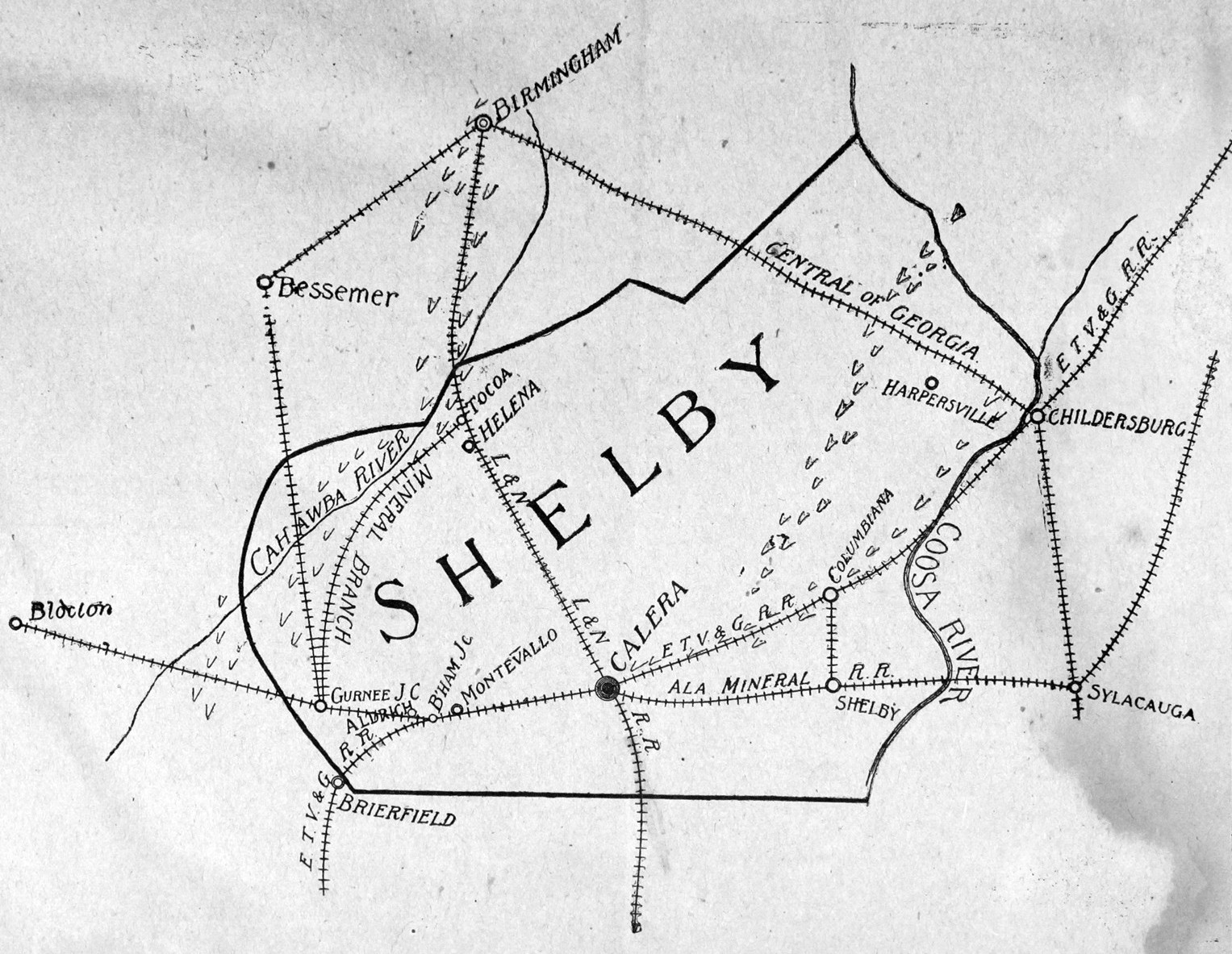 In 1904 Calera was the "Railroad Center of Shelby
County"
In 1904 Calera was the "Railroad Center of Shelby
County"
from the Shelby County Sentinel published in Calera, Alabama
A Picture of Old Calera
Mary Nichols Curtis
I may never see a picture of old Calera
But I carry one in my mind -
A collage from my early days
Entwined with family tales:
Small frame houses and the old drugstore,
Backyard gardens with poppies and marigolds,
The taste of cool water from the well,
The Salem Cemetery on the hill
With old graves and wild flowers,
The L&N train roaring in to the old depot,
And tiny simple churches,
Winding country roads
Around mounds of Cherokee roses,
And arrowheads from ancient days
And a covered bridge
And the cooperage with its fragrance of yellow pine,
And the great lime kiln that towered high,
Sifting its fine white powder over all.
Bleak and ugly, sometimes - that lime kiln -
But at other times
Caught in light against a dark blue sky,
Stark and dramatic and unforgettable,
To be stored away in memories
And sometimes brought out
To get one through the day.
~ Appeared in 1978 ALALITCOM, the publication of
The Alabama Ariters' Conclave ~
Copyright - Bobby Joe Seales - 2000
|
